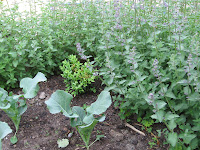 She wishes we didn't call them that, saying she got the recipe from a magazine years ago. But that's what we call these cookies at RCGC, remembering them fondly from the many times former Board member Shirley Dumbauld brought them to our Christmas parties. I made them for our recent Christmas soiree and they were a big hit. For those of you who requested the recipe (and even if you didn't, they're really great Christmas cookies):
She wishes we didn't call them that, saying she got the recipe from a magazine years ago. But that's what we call these cookies at RCGC, remembering them fondly from the many times former Board member Shirley Dumbauld brought them to our Christmas parties. I made them for our recent Christmas soiree and they were a big hit. For those of you who requested the recipe (and even if you didn't, they're really great Christmas cookies):Christmas Snowball Cookies
1 C butter, softened
1/4 C sifted confectioners sugar
2 tea vanilla
1 T water
2 C sifted flour
1 C chopped pecans
Confectioners' frosting:
4 C sifted confectioners' sugar
1/2 C milk (or less)
Coating: 8 oz flaked, sweetened coconut
Thoroughly cream butter, sugar and vanilla. Stir in water. Add flour and mix well. Stir in nuts. Roll into 1-inch balls. Place on an ungreased cookie sheet (they can be placed fairly close as they don't spread very much) and bake for 20 min at 300 deg, or until delicately browned. Cool completely before removing from pan. Dip in confectioners frosting and roll in flaked coconut.
Confectioners' Frosting: mix milk slowly into the sifted sugar, a little at a time, until of dipping consistency.
Yeild: about 30 cookies


















 http://www.umassgreeninfo.org/fact_sheets/defoliators/lily_leaf_beetle.html
http://www.umassgreeninfo.org/fact_sheets/defoliators/lily_leaf_beetle.html













